For the last decade, the renowned yet mysterious street artist Banksy has continued to grow in popularity. And whilst his influential murals are central to his artform, their location and complexity in ownership make them hard for a collector to obtain. Therefore, the market for Banksy prints is stronger than ever, with numbered pieces often taking pride of place in a public or private collection.
Above: our team featured on local news about the conservation of Banksy’s murals
Our team of conservators were key in ensuring the preservation of various murals by Banksy, including works in Glasgow for the ‘Peace is Tough’ exhibition, the ‘Snorting Copper’ mural in Shoreditch, and the Extinction Rebellion piece at Marble Arch. These unusual artworks required our team to problem solve in a new area of art preservation, which has become increasingly more important to the art world in recent years.
 Above: our specialist conservator maintaining the Banksy mural at Marble Arch for Westminster Council
Above: our specialist conservator maintaining the Banksy mural at Marble Arch for Westminster Council
Problem-solving is an important skill for a conservator, as our team is often faced with unusual types of damage or interesting new materials. In the conservation of paper, this is key in understanding the vulnerabilities faced by Banksy prints, which do not always use traditional mediums. In fact, due to the lack of context behind the production of some original prints, both the owner and our conservator will have to investigate to establish how it was made and which risks it might face.
 Above: our team has also professionally removed several Banksy murals for sale and preservation
Above: our team has also professionally removed several Banksy murals for sale and preservation
These works on paper may not always be computer prints, often they are screenprints that include ink, paint, or spray paint. This will be carefully analysed by our ICON accredited paper conservator, who will know the appropriate steps to take if the piece requires restoration.
Like most works on paper, these artworks are at risk from their environment. Whether this is from sunlight, humidity, contamination, or accidental damage.
The value of Banksy prints
- ‘Girl With A Balloon’ is the most valuable, with an estimate of between £350,000 to £400,000.
- A collection of 50 signed and 250 unsigned Tesco branded soup can prints have the lowest recent sale price of just over £8,000. However, their value is still expected to increase in future sales.
- “Love Is In The Air” or “Flower Thrower” was originally stencilled on the West Bank wall in Bethlehem. Original prints are estimated at £300,000-£350,000.
- Based on a series in New Orleans depicting colourful rain, Banksy’s NOLA prints vary in value, the most sought after is entitled ‘Yellow Rain’.
- ‘Kate’ depicting Kate Moss as Andy Warhol’s Marilyn Monroe is estimated at £200,000-£250,000
Temperature and humidity
The paper used in some Banksy prints may be weaker due to it not being traditional watercolour paper or card, in some instances simple craft paper is used. With this in mind, it is important to be extra vigilant when maintaining the correct environment.
 Above: a Banksy print which was later re-framed by our team to ensure its safety
Above: a Banksy print which was later re-framed by our team to ensure its safety
We recommend that the surrounding humidity and temperature for a print is that of a museum standard. Humidity should be around 35-50% with an even temperature of 20 degrees celsius which does not drastically fluctuate. High humidity could lead to foxing (rusty brown spots) and mould spores spreading across the paper. Low humidity may cause the paper to lose all moisture and become weak, which is why these environments must be kept at an even level. If mould, foxing, or brittle decay occur, our conservator can stabilise and cleanse the paper to resolve these effects, but this should be arranged as soon as possible to minimise damage.
Accidental damage and visual disturbances
When a print is not on display, it is important that it is kept within a frame, or flat within a protective non-acidic cover. Never roll the paper, as this may weaken it and lead to flaking or creasing.
Accidental damage may occur due to the paper being vulnerable to tears, folds, creasing, or spills. In storage, it may also come across pests if it is not properly protected. If any of these issues occur it is best to contact our team as soon as possible to minimise deterioration.
 Above: a selection of popular Banksy prints
Above: a selection of popular Banksy prints
Accidental marks and stains can more often than not, be removed by our conservation team in most instances, a customised solution is used to carefully clean away any discolouration or visual disturbance. However, it is important to check whether any of the marks are original to the piece. The nature of Banksy artwork might mean that stains and disturbances which appear accidental, maybe part of the original intention or production process.
Our conservator was able to gently remove staining from a Banksy print known as ‘Applause’. This piece ironically depicts two workers on a military aircraft carrier holding up an applause sign associated with a cheering television audience. This had staining to the paper in the surrounding area, which had obviously occurred after production. This was gently removed with custom solutions before the print was given a safe new frame.
Original framing and unsafe materials
Banksy prints may have been exposed to an original mount, backing board, or frame which is not appropriate for their conservation. High-risk framing may include toxic elements which will discolour and decay the piece over time. The question is often whether intervention is appropriate, keeping in mind that these materials were applied by the artist and part of their original intention for the work. Given the cultural and monetary value of a Banksy print, most collectors would consider at least a partial conservation approach to maintaining as much of the original material as possible.
Our team is ethically trained and adheres to conservation principles. As such, we will never discard original aspects of an artwork unless instructed to do so for the protection of the piece, with acknowledgement from the owner. If there is no sign of contamination, there will be no question that the original mount and frame should remain as part of the print. The frame or mount can then be carefully cleaned and preserved alongside the artwork. If it is decided that acidic materials should be carefully removed, our team will also ensure that toxic elements are cleaned away, the paper is stabilised on a conservation-appropriate material, and discolouration or staining is reduced.
 Above: our conservator can remove acidic backing boards and clean away any build up of harmful contamination
Above: our conservator can remove acidic backing boards and clean away any build up of harmful contamination
Unusual and unsafe materials may also have been casually applied during impromptu framing or after an accident. This includes the use of sticky tape, which we often find on the backs of prints or applied by an owner to a torn area. The glue in sticky tape can cause acidic decay and heavy discolouration. Our conservator will work to remove any toxic elements, as well as clearing away the visual disturbance.
Sunlight and fading
Both the paper and colours used may begin to deteriorate if a print is displayed in direct sunlight, as the UV rays encourage fading and a brittle surface. Once ink or paint has faded, this is not an aspect that can be easily replaced or restored. Therefore, UV protective glass or window seals are important. 70-99% UV protective glass can be offered as part of our framing process, in which our team can provide a tailored portfolio of options to suit the piece.
 Above: a selection of Banksy prints including Girl With Balloon and Flower Thrower
Above: a selection of Banksy prints including Girl With Balloon and Flower Thrower
Even with UV protection in place, it is important to keep any print away from a sunny location. The best way to provide full protection is to keep it in an area with no more than 50 LUX lighting. As you may not always know which materials have been used in a Banksy print, it is best to use a full range of protective techniques and to treat the artwork as a highly fragile piece.
Restoring Banksy prints
Our paper conservator has worked on several works on paper by Banksy, including an original ‘Rude Copper’ screen print, one of the street artist’s earliest artworks from 2002. This motif was originally part of an unsigned collection of 250 prints, however, there is a rare selection of 30 which have a hand-finished silver spray paint on them. The artwork was inspired by the 2000 Terrorism Act, this gave police the power to stop and search without suspicion; the depicted ‘Rude Copper’ reflects how this power was interpreted by some parts of society. Our client’s print was one of the hand-finished few, making it highly sought after in the art market.
 Above: the Rude Copper print before and after restoration by our specialist paper conservator
Above: the Rude Copper print before and after restoration by our specialist paper conservator
The print had fallen from a height, suffering from broken glass which had visually disturbed the solid black areas of the stencil. Our conservator gently removed any creasing or disturbance in the paper with a weight treatment, the disrupted area was also seamlessly retouched with a matching pigment which is safe and appropriate for the conservation of the piece.
Get in touch with our team
Our conservators can perform a wide variety of treatments to resolve damages, if you have any concerns about a Banksy print do not hesitate to get in touch.
Please email [email protected] or call 0207 112 7576 for further advice and to arrange a full assessment of your print by our knowledgeable team.

 Above: our specialist conservator maintaining the Banksy mural at Marble Arch for Westminster Council
Above: our specialist conservator maintaining the Banksy mural at Marble Arch for Westminster Council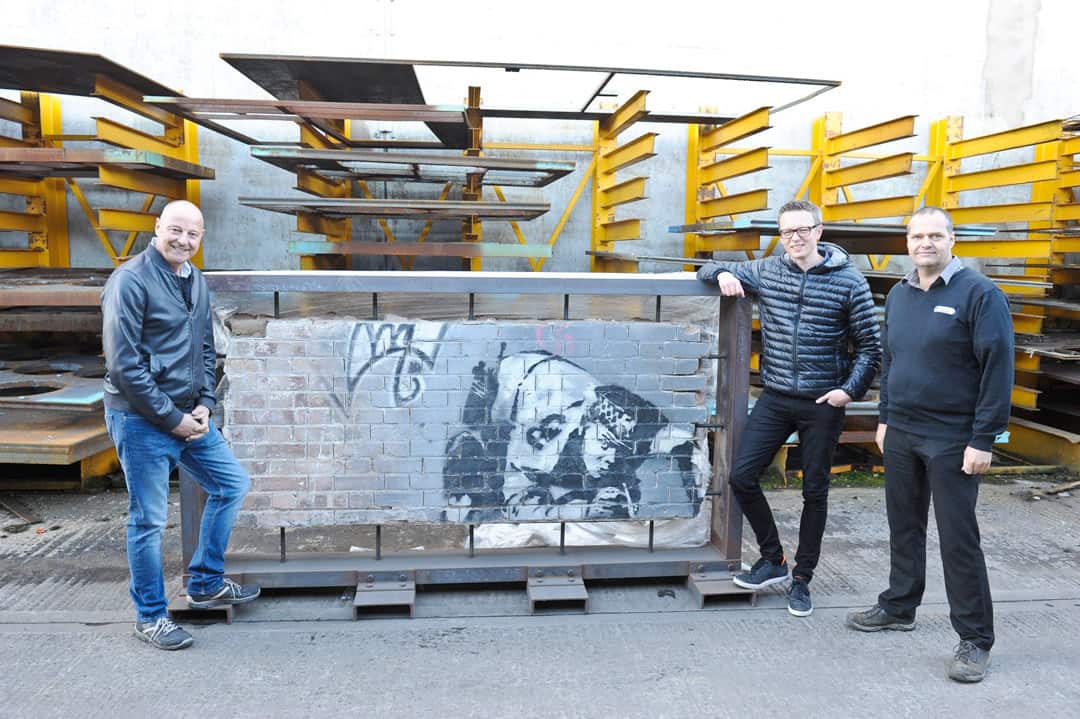 Above: our team has also professionally removed several Banksy murals for sale and preservation
Above: our team has also professionally removed several Banksy murals for sale and preservation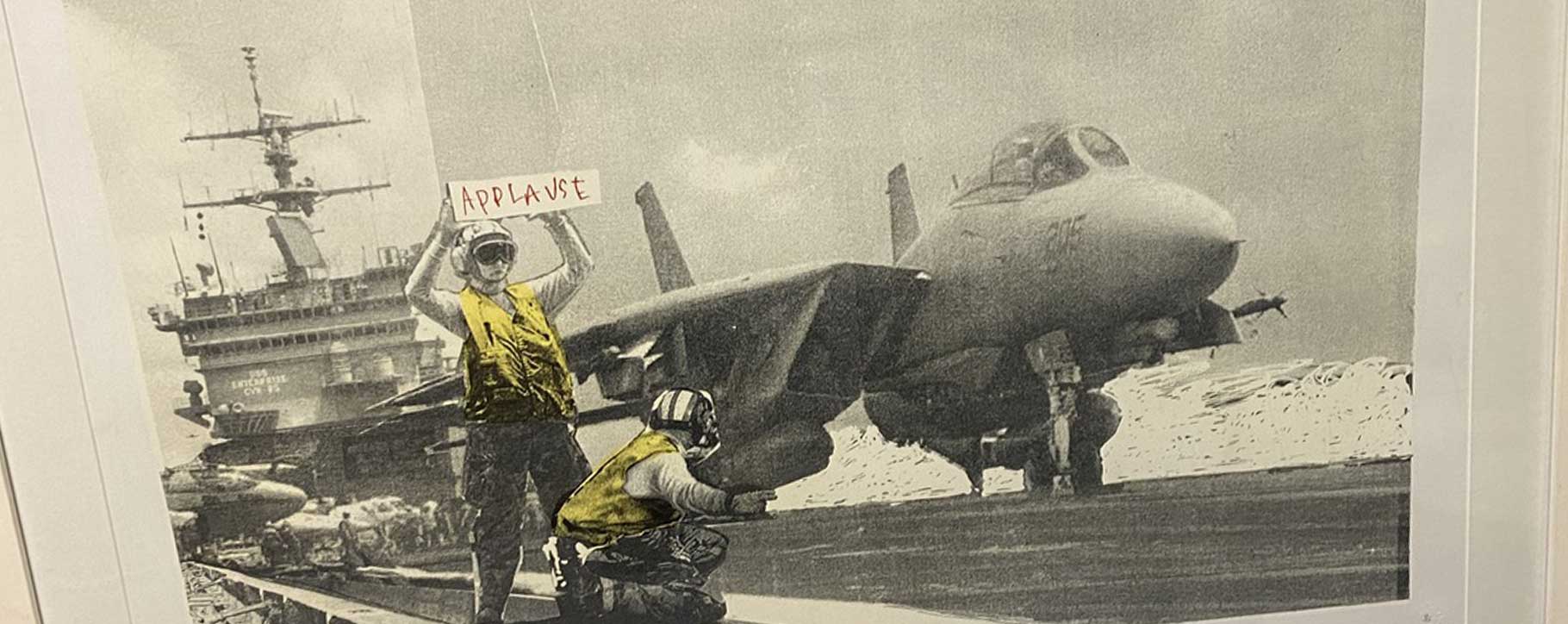 Above: a Banksy print which was later re-framed by our team to ensure its safety
Above: a Banksy print which was later re-framed by our team to ensure its safety Above: a selection of popular Banksy prints
Above: a selection of popular Banksy prints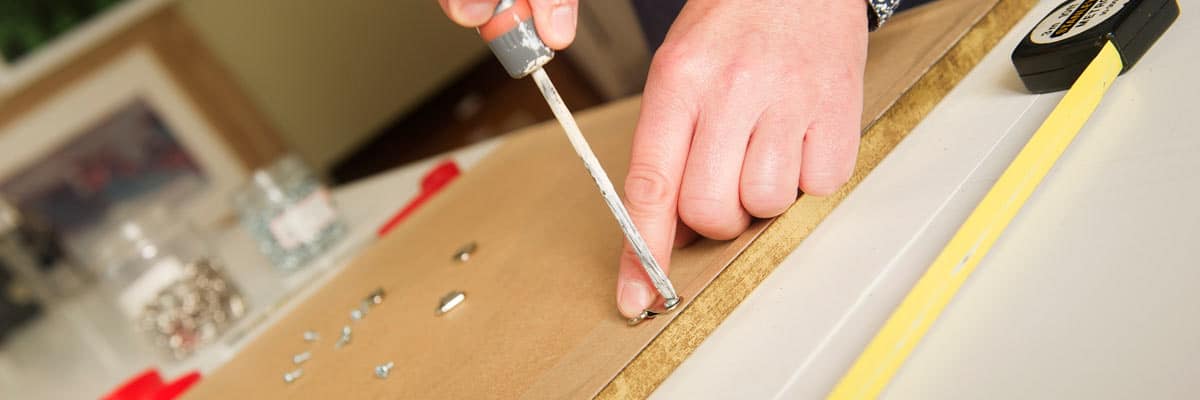 Above: our conservator can remove acidic backing boards and clean away any build up of harmful contamination
Above: our conservator can remove acidic backing boards and clean away any build up of harmful contamination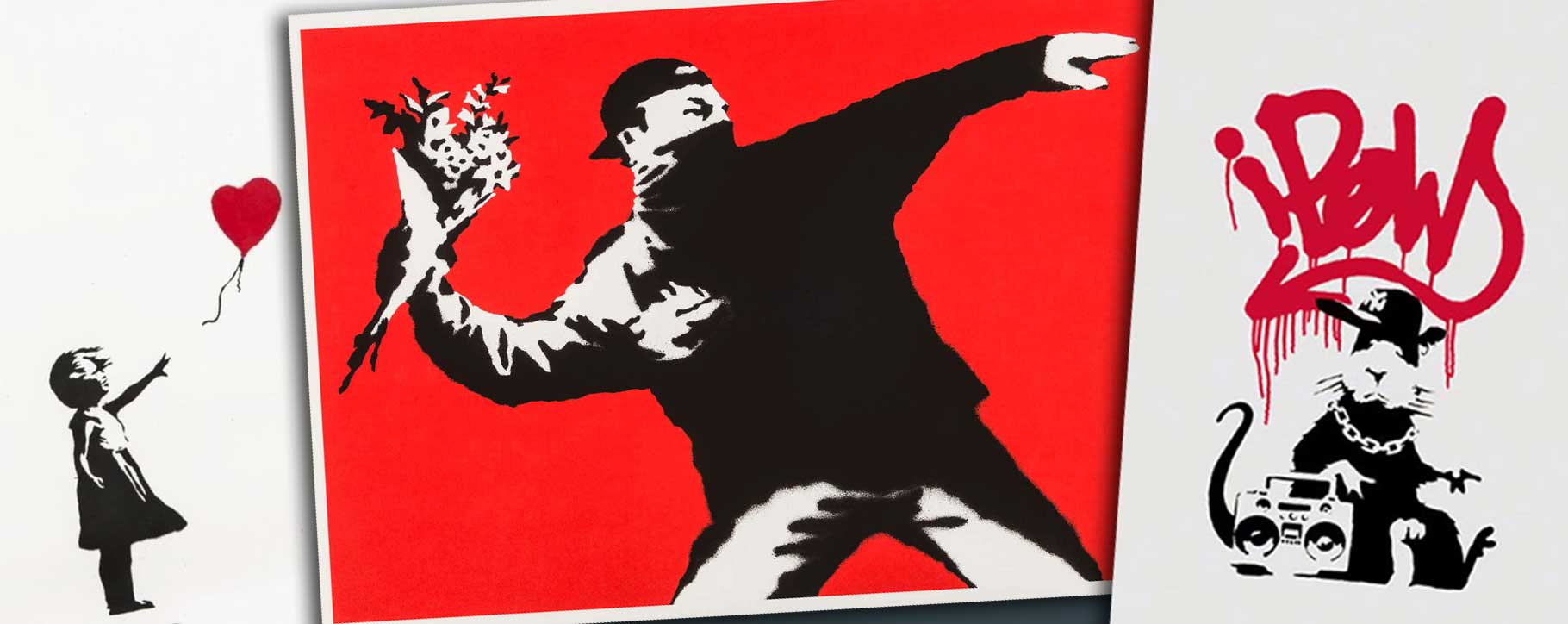 Above: a selection of Banksy prints including Girl With Balloon and Flower Thrower
Above: a selection of Banksy prints including Girl With Balloon and Flower Thrower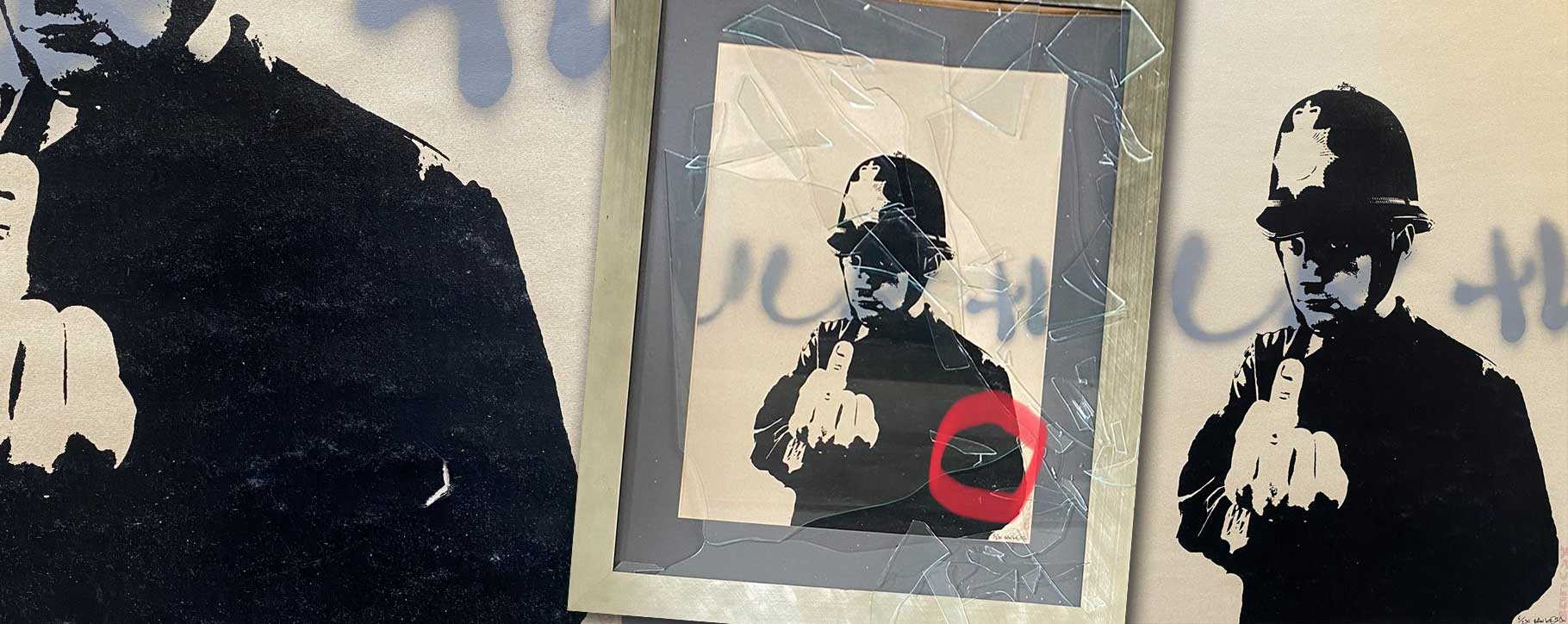 Above: the Rude Copper print before and after restoration by our specialist paper conservator
Above: the Rude Copper print before and after restoration by our specialist paper conservator




